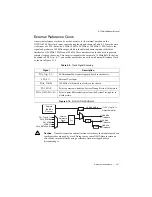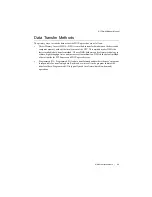
© National Instruments
|
2-21
Analog Edge Triggering With Hysteresis
When you add hysteresis to analog edge triggering, you add a window above or below the trigger
level. This trigger often is used to reduce false triggering due to noise or jitter in the signal. For
example, if you add a hysteresis of 1 V to the example in Figure 2-12, which uses a level of
3.2 V, the signal must start at or drop below 2.2 V to arm the trigger. The trigger asserts when
the signal rises above 3.2 V and deasserts when it falls below 2.2 V, as shown in Figure 2-13.
Figure 2-13.
Analog Edge Triggering with Hysteresis on Rising Slope
When using hysteresis with a falling slope, the trigger is armed when the signal starts above
Level, plus the hysteresis value, and asserts when the signal crosses below Level. For example,
if you add a hysteresis of 1 V to a level of 3.2 V, the signal must start at or rise above 4.2 V to
arm the trigger. The trigger asserts as the signal falls below 3.2 V and deasserts when it rises
above 4.2 V, as shown in Figure 2-14.
Figure 2-14.
Analog Edge Triggering with Hysteresis on Falling Slope
Level
Hy
s
tere
s
i
s
3
.2 V
2.2 V
An
a
log Comp
a
ri
s
on
Reference Trigger
Level
An
a
log Comp
a
ri
s
on
Hy
s
tere
s
i
s
4.2 V
3
.2 V
Reference Trigger








































